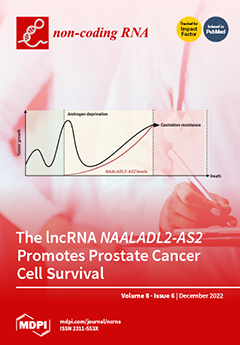Open AccessArticle
The Androgen Regulated lncRNA NAALADL2-AS2 Promotes Tumor Cell Survival in Prostate Cancer
by
Levi Groen, Viktor Yurevych, Harshitha Ramu, Johnny Chen, Lianne Steenge, Sabrina Boer, Renske Kuiper, Frank P. Smit, Gerald W. Verhaegh, Niven Mehra and Jack A. Schalken
Cited by 4 | Viewed by 3766
Abstract
Castration resistance is the leading cause of death in men with prostate cancer. Recent studies indicate long noncoding RNAs (lncRNAs) to be important drivers of therapy resistance. The aim of this study was to identify differentially expressed lncRNAs in castration-resistant prostate cancer (CRPC)
[...] Read more.
Castration resistance is the leading cause of death in men with prostate cancer. Recent studies indicate long noncoding RNAs (lncRNAs) to be important drivers of therapy resistance. The aim of this study was to identify differentially expressed lncRNAs in castration-resistant prostate cancer (CRPC) and to functionally characterize them in vitro. Tumor-derived RNA-sequencing data were used to quantify and compare the expression of 11,469 lncRNAs in benign, primary prostate cancer, and CRPC samples. CRPC-associated lncRNAs were selected for semi-quantitative PCR validation on 68 surgical tumor specimens. In vitro functional studies were performed by antisense-oligonucleotide-mediated lncRNA knockdown in hormone-sensitive prostate cancer (HSPC) and CRPC cell line models. Subsequently, cell proliferation, apoptosis, cell cycle, transcriptome and pathway analyses were performed using the appropriate assays. Transcriptome analysis of a prostate cancer tumor specimens unveiled
NAALADL2-AS2 as a novel CRPC-upregulated lncRNA. The expression of
NAALADL2-AS2 was found to be particularly high in HSPC in vitro models and to increase under androgen deprived conditions.
NAALADL2-AS2 knockdown decreased cell viability and increased caspase activity and apoptotic cells. Cellular fractionization and RNA fluorescent in situ hybridization identified
NAALADL2-AS2 as a nuclear transcript. Transcriptome and pathway analyses revealed that
NAALADL2-AS2 modulates the expression of genes involved with cell cycle control and glycogen metabolism. We hypothesize that the nuclear lncRNA,
NAALADL2-AS2, functions as a pro-survival signal in prostate cancer cells under pressure of targeted hormone therapy.
Full article
►▼
Show Figures






